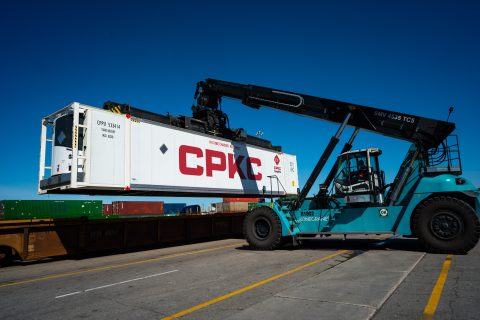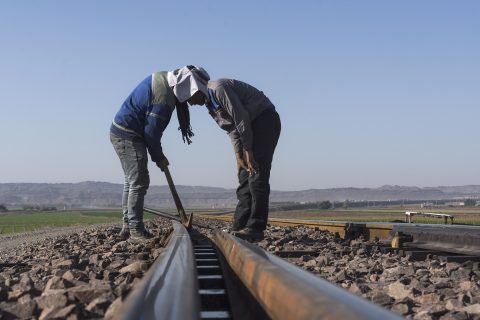A tour through Iran as a rail freight transit country

Iran is strategically located to serve as a transit country on a variety of international rail freight corridors. Where does Iran stand today? Babak Ahmadi, Member of the Board of the Railways of the Iranian Republic of Iran (RAI) took us on a tour through the Iranian rail freight network at UIC’s Global Rail Freight Conference held in Genoa last month.
Iran is one of the main transit countries on what is referred to as ‘the southern routes’ on the New Silk Road. Together with Turkey, it provides transit to south-east European countries such as Bulgaria, Greece or Romania. In the other direction, freight traffic travels through Iran on the way to China, India, Pakistan and Afghanistan. Moreover, east-west traffic is not the only focus; the North-South Transport Corridor connects Russia to India via Iran and has several branches serving nearby destinations.
Connecting to China
Rail freight services from Iran to China have been on the map since 2016. The first freight train took off from Yiwu in January that year, headed for Tehran. A second freight train service connecting Yinchuan and Tehran followed in September that year. In May this year, a new connection was established from Bayannur city in north China’s Inner Mongolia Autonomous Region to Tehran. At the moment, there are two possible routes for traffic between China and Iran; a route passing through Kazakhstan, Uzbekistan and Turkmenistan and a similar route, but bypassing Uzbekistan.
The first route is part of the Almaty-Bandar Abbas corridor entering Iran through the border point of Sarakhs. This corridor was opened in 2011 and has the potential to lift 2 million tonnes of freight annually. The latter is part of the East of Caspian Route and passes through the Inche-Burun border crossing. As Ahmadi showed, this route is a branch of the north-south corridor, which starts in Russia and runs all the way up till the Persian Gulf. However, this line runs diverts east of the Caspian Sea to pass through Kazakhstan and Turkmenistan. The railway line was launched at the end of 2014 and foresees transporting some 15 million tonnes of cargo annually by 2022.
Another route between China and Iran runs through Kyrgyzstan, Tajikistan and Turkmenistan and is part of the Istanbul-Almaty corridor. This corridor was established in 2002 and although traffic between Turkey and Iran is regular, the infrastructure east of Iran is insufficient to provide with the required capacity, according to Roland Berger.
Connecting to Europe
Through the Istanbul-Almaty corridor, Iran is connected to Turkey and from there, regular services are provided to Cologne in Germany via Bulgaria, Romania, Hungary and Austria. Last year August, Iran and Turkey committed to enhancing rail freight traffic via this route with the objective of handling a million tonnes of freight via the Razi border crossing. When sanctions on Iran were lifted in 2016, various European companies expressed their interest in developing rail freight services along this corridor, among them the German firms DHL, DB Cargo and DB Schenker. The same companies are exploring a multimodal route bypassing Turkey. This route includes the railway line Cologne-Romania, but diverts onto the black sea. Vessels carry the freight across to Georgia, where it is transported by rail and truck to Tehran via Azerbaijan.
Meanwhile, the south-west offshoot of the North-South Transport Corridor is coming up as an alternative route linking Europe with Iran. This route connects Slavkov in Poland, Ilyichevsk in Ukraine, Batumi in Georgia, Baku in Azerbaijan, Astara in Turkmenistan and Bandar Abbas in Iran on a 12-day journey covering a distance of 5,311 kilometre. In May this year, the Azerbaijani A.D.E. Container Company and the Swiss Hupac Intermodal successfully carried out a test run, with the intention to establish a regular service.
Connecting to India, Pakistan and Afghanistan
Iran is currently developing the Chabahar-Herat railway corridor, connecting Afghanistan and the Indian Ocean at the Port of Chabahar, Babak explained. The project comprises of two parts; one line links the Port of Chabahar to the existing Sarakh-Balkh railway at Shamligh, while a second line connects the Iranian city of Khaf with Herat. As Afghanistan produces a lot of minerals this corridor is expected to enhance export volumes of the landlocked country significantly.
Also under development is the North–South Transport Corridor connecting India, Iran, Azerbaijan and Russia via ship, rail and road. It is a 7,200 kilometer-long freight route set to reduce journey times between Mumbai and Moscow from forty to fourteen days. Test runs have already been carried out. However, two sections of the line situated in Iran are still under construction; a line connecting Astara with Rasht and a line connecting Rasht with Qazvin. It is anticipated that in the future ten million tonnes of freight will be transported within the network, especially as it also feeds the north-west offshoot to and from Europe.
Finally, Iran also provides a link to Pakistan through the Istanbul-Tehran-Islamabad corridor. This corridor was established in 2009, but has been in testing phase since then. The corridor enables transit along the 6,543 kilometre journey in ten days, bringing Pakistan closer to Europe.
You just read one of our premium articles free of charge
Want full access? Take advantage of our exclusive offer






